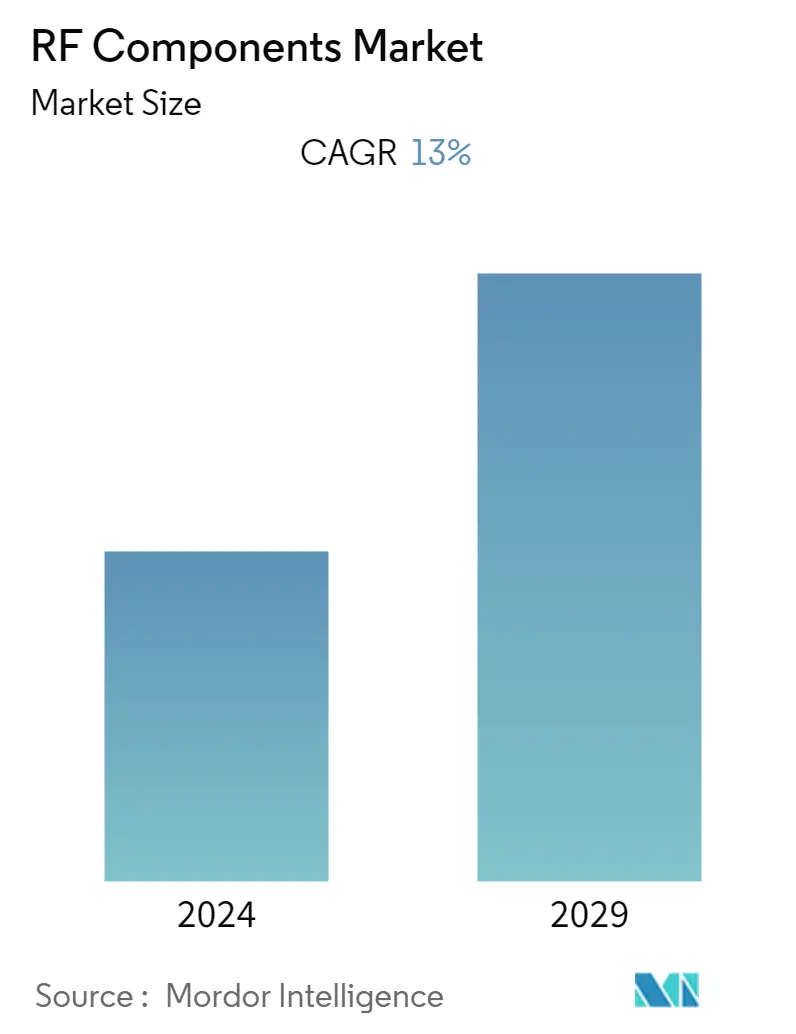Market Size of RF Components Industry

| Study Period | 2019 - 2029 |
| Base Year For Estimation | 2023 |
| CAGR | 13.00 % |
| Fastest Growing Market | Asia Pacific |
| Largest Market | Asia Pacific |
| Market Concentration | Low |
Major Players
*Disclaimer: Major Players sorted in no particular order |
Need a report that reflects how COVID-19 has impacted this market and its growth?
Radio Frequency (RF) Components Market Analysis
The RF components market is expected to grow at a CAGR of 13% over the forecast period (2021-2026). Radio Frequency (RF) technology is vital to many sides of modern electronics. RF engineering is incorporated into almost everything helping to transmit or receiving a radio wave across the complete RF spectrum (3 kHz to 300 GHz) that includes cellular phones, radios, Bluetooth, and Wi-Fi technology. With the advent of the Internet of Things (IoT) and even greater wireless connectivity, there will be increased demand for RF components.
- Advancement in Electronic Warfare (EW) Technology caters to the demand for RF components, which helps to drive the market. EW is the use of electromagnetic and directed energy controlling the electromagnetic spectrum. Major defense contractors shall incorporate more and more EW technology into their products in the coming decade. Lockheed-Martin, for example, features sophisticated EW technology in their new F-35 fighter allowing it to block energy frequencies and suppress radar. Many of these new EW systems utilize gallium-nitride (GaN) devices helping to meet their demanding power requirements with low-noise amplifiers (LNA). Additionally, the use of unmanned vehicles (UAV) on land, in the air, and the sea will also increase, along with a need for sophisticated RF solutions to communicate with and control these machines on secure networks.
- Further, in the military and the commercial sector, the need for advanced RF solutions for satellite communications (SATCOM) will penetrate to increase. One particularly ambitious project requiring advanced RF engineering is the global Wi-Fi project from SpaceX, which will require over 42,000 satellites into orbit to beam wireless internet down to people all over the world till 2020, using frequencies of 10-30ghz, in the Ku and Ka-band range.
- The adoption of front-end modules in telecom drives the market. According to Ericsson, the expected 5G mobile subscription until 2024 is 1903 million units. 5G base stations and handsets will rely on higher-end RF front-end modules and power amplifiers to meet requirements for increasingly sophisticated and efficient communication performances. Volumes of transceiver filters, RF switches, and PA devices needed for 5G handsets will grow exponentially compared to those for 4G models. The mmWave 5G smartphones also will need more RF devices than sub-6GHz models, fueling the demand for AiP (antenna in the package) technology that can prevent mmWave signal interference.
- Further, third-generation compound semiconductors will also be increasingly applied to 5G base stations, as III-V semiconductor materials, especially GaN, can facilitate the construction of transmission systems smaller in size and lower in power consumption and cost.
- The sudden outbreak of the COVID-19 pandemic is likely to affect the RF Components market. With the slowdown of smartphone sales, OEMs are resistant to higher the bills of material, and an economic downturn in China will all result in curtailing the growth of RF front-end components used in mobile phones and other cellular user equipment. For instance, Huawei announced delays in launching 5G mobile networks in Europe.
- Further, according to ESM China, Murata and Samsung's MLCCs (multilayer ceramic chip capacitors commonly used in RF circuits) are used primarily in high-end markets such as smartphones, automobiles, industrial, and medical equipment. The suspension of production from Murata and Samsung will have a market impact on the high-end RF components market.
- Also, according to IEA, vehicle sales in China declined 43.3 percent year-on-year to 1.428 million in March of 2020, following a 79 percent plunge in the previous month, which was the steepest yearly decline on record and March marked the 21st month of decline in vehicle sales. Due to the declining demand for vehicles, the demand for RF components is negligible, causing oversupply, which is leading to immediate damage to the RF components revenues.
